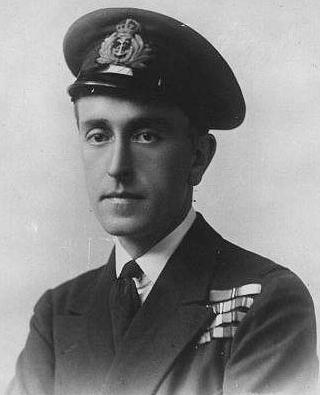by Scott Mehl © Unofficial Royalty 2017

George Mountbatten, 2nd Marquess of Milford Haven. source: Wikipedia
George Mountbatten, 2nd Marquess of Milford Haven was born on December 6, 1892, at the Neues Palais in Darmstadt, Grand Duchy of Hesse and by Rhine, now in Hesse, Germany. At the time of his birth, he was HSH Prince George Louis Victor Henry Serge of Battenberg, the third child and elder son of Prince Ludwig (Louis) of Battenberg and Princess Victoria of Hesse and by Rhine. George had three younger siblings:
- Princess Alice of Battenberg (1885-1869) – married Prince Andreas of Greece, had issue
- Princess Louise of Battenberg (1889-1865) – married King Gustaf VI Adolf of Sweden, no issue
- Prince Louis, Earl Mountbatten of Burma (1900-1979) – married Edwina Ashley, had issue

George with his mother, Victoria. Credit – Wikipedia
A remarkably intelligent and clever child, George had his own workshop at his father’s Heiligenberg Castle by the age of ten and was soon designing and building precise working models of steam engines. He enjoyed complex math problems “for relaxation” and was recognized by his superiors at Dartmouth Naval College for being perhaps the most clever cadet the college had ever seen. During his time in the Royal Navy, he devised a system to provide air conditioning in his cabin and invented a device that would brew his morning tea, triggered by an alarm clock.

Wedding portrait of George and Nadejda.
On November 15, 1916, at the Russian Embassy in London, England, George married Countess Nadejda Mikhailovna de Torby. Nadjeda was born in Cannes on March 28, 1896, the younger daughter of Grand Duke Mikhail Mikhailovich of Russia and Countess Sophie von Merenberg. Following their wedding, George and Nadejda settled at Lynden Manor, in Bray, Berkshire, and had two children:
- Lady Tatiana Mountbatten (1917-1988) – unmarried, was mentally disabled, was placed in St. Andrew’s Hospital, a psychiatric hospital in Northampton, England, where she spent the rest of her life.
- David Mountbatten, 3rd Marquess of Milford Haven (1919-1970) – married (1) Romaine Pierce, no issue; (2) Janet Bryce, had issue
In 1917, King George V of the United Kingdom asked his relatives to relinquish their German royal titles. On July 14, 1917, the Battenbergs gave up their titles and styles and took on the surname Mountbatten. George, having previously been created a Knight Commander of the Royal Victorian Order, became Sir George Mountbatten. Four months later, on November 7, 1917, his father was created Marquess of Milford Haven, and George assumed the courtesy title Earl of Medina. Four years later, in 1921, when his father died, George became the 2nd Marquess of Milford Haven.
In the late 1920s, having lost most of his inheritance to German inflation and having a wife with very expensive tastes, George left the Royal Navy for a career in business. He worked for a brokerage house before moving to the British Sperry Gyroscope Company where he became chairman. He also served as director for several large companies, including Electrolux and Marks & Spencer.
In 1930, George became instrumental in the upbringing of his nephew Prince Philip of Greece. Philip’s mother Princess Alice of Battenberg suffered a breakdown that year, and his father Prince Andreas of Greece was more or less separated from the family, living with a mistress on the French Riviera. George became Philip’s primary guardian, serving as a surrogate father and arranging and financing Philip’s education.
In 1934, George and Nadejda were brought into the international spotlight during the custody battle for the young Gloria Vanderbilt in New York City. Allegations had been raised that Nadejda and Gloria’s mother Gloria Morgan Vanderbilt had been lovers. Nadejda traveled to New York to testify in the case, decrying the allegations as “malicious, terrible lies.”
In December 1937, George suffered a fall and broke his femur. A month later, when the injury did not appear to be healing, a further examination found that he was suffering from bone marrow cancer. Fearing that the diagnosis would cause him to decline quite quickly, the doctors chose to withhold it from him, in agreement with the family. George lingered for several months, finally losing his battle on April 8, 1938, in London, England. He is buried at the Bray Cemetery in Bray, Berkshire, England. George had accumulated a large collection of erotic art, which he left on permanent loan to the British Library. The library’s index describes the collection as “prospectuses and catalogs of erotic and obscene books, pictures and instruments, dating from 1889 to 1929. 81 parts. Collected by George Mountbatten.”
This article is the intellectual property of Unofficial Royalty and is NOT TO BE COPIED, EDITED, OR POSTED IN ANY FORM ON ANOTHER WEBSITE under any circumstances. It is permissible to use a link that directs to Unofficial Royalty.


























